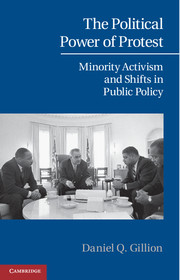Book contents
- Frontmatter
- Contents
- List of Figures
- List of Tables
- Preface
- Acknowledgments
- Introduction
- 1 A Continuum of Information
- 2 Measuring Information in Minority Protest
- 3 Viewing Minority Protest from the Hill
- 4 Knocking on the President’s Door
- 5 Appealing to an Unlikely Branch
- Conclusion
- Appendix A Defining Minority Political Protest
- Appendix B Study Description and Coding Across Multiple Institutions
- Appendix C Time Series Methods
- References
- Index
3 - Viewing Minority Protest from the Hill
The Individual and Collective Response from Congress
Published online by Cambridge University Press: 05 February 2013
- Frontmatter
- Contents
- List of Figures
- List of Tables
- Preface
- Acknowledgments
- Introduction
- 1 A Continuum of Information
- 2 Measuring Information in Minority Protest
- 3 Viewing Minority Protest from the Hill
- 4 Knocking on the President’s Door
- 5 Appealing to an Unlikely Branch
- Conclusion
- Appendix A Defining Minority Political Protest
- Appendix B Study Description and Coding Across Multiple Institutions
- Appendix C Time Series Methods
- References
- Index
Summary
The anger that you see expressed out there in Los Angeles, in my district this evening, is a righteous anger, and it’s difficult for me to say to the people, “Don’t be angry.”
– Representative Maxine Waters (D-CA)The signals from minority protest have become weaker and more dispersed throughout the nation. As the context of minority protest has changed over time, so too have national political institutions transformed since the 1960s. Congress in particular has experienced a significant change in the demographic makeup of elected representatives. The early 1970s ushered in a wave of black and Latino legislators, many of whom emerged from the protest activities of the 1960s. The two major political parties also grew in importance and began exercising more influence over their representatives in Congress, pushing members to make stronger appeals to racial and ethnic minority voters. These changes created an environment in which minority protest appeals, though declining in salience, nonetheless retained strong potential to resonate.
As the “people’s institution” of government, Congress is the branch perhaps most apt to be responsive to the political actions of engaged citizens. However, it can be difficult to assess congressional responsiveness. The LA riots of 1992 and the subsequent governmental response by Representative Maxine Waters demonstrate that protest conveys information to representatives at both district and national levels. As this case study will suggest, it is the protests that originate within a given representative’s district that are the true catalysts for changing the behavior of congressional leaders, as opposed to those occurring elsewhere.
- Type
- Chapter
- Information
- The Political Power of ProtestMinority Activism and Shifts in Public Policy, pp. 57 - 83Publisher: Cambridge University PressPrint publication year: 2013



